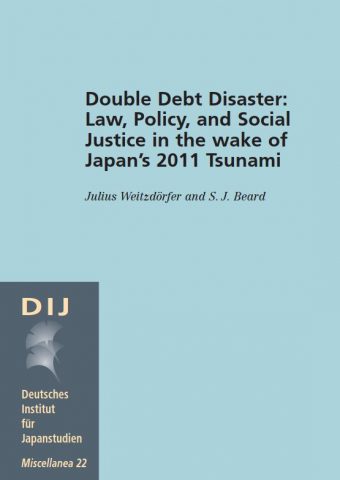
Download
Einzelheiten
2021, ISSN 0941-1321, Deutsches Institut für Japanstudien, Tokyo, 106 p.Autoren
Double Debt Disaster
Law, Policy, and Social Justice in the wake of Japan’s 2011 Tsunami

Double Debt Disaster offers a detailed examination of an increasingly serious and widespread, yet underexamined, phenomenon: obstacles to recovery from catastrophes caused by the concurrence of pre-disaster obligations with post-disaster capital needs and the destruction of collateral assets. The convergence of growing risk from natural hazards, from projected sea-level rise, storm surges, floods, and other extreme weather events, coupled with ever-higher levels of public and private indebtedness will soon propel the quest for micro-and macro-economic policy solutions to such problems from regional to global attention. No case is more instructive for understanding these problems than the Great East Japan Earthquake and Tsunami, which damaged one million buildings, rendered 300,000 victims displaced and dispossessed, and entered history as the costliest disaster prior to the COVID-19 pandemic. In its wake came a second disaster, as former home-owners and businesspeople found themselves in need of loans to rebuild and invest, while being unable to pay off pre-disaster debts. These “double-loan problems” (nijû saimu mondai) promote private and corporate insolvency, threaten financial institutions, jeopardize disaster recovery, and entrench social inequality.
Treating issues of property-, insurance-, debtor-creditor-, social welfare-, charity-, financial-, and insolvency law, this volume examines Japan’s double debt disaster from the perspective of social justice and disaster recovery. After analysing the issue, it assesses the law and policy responses to disaster-induced debt. Drawing on Japanese and western scholarship, the study then critically discusses normative concepts underlying disaster relief, disaster capitalism, and social justice considerations. Finally, based on the socioeconomic situation, the legal analysis, and the justice considerations, it gives policy recommendations to improve the way in which burdens of uninsured risk and recovery are to be shared as a lesson for future disasters, including the current pandemic.
It is hard to account for the double loan crisis, and even harder to remedy it, using only traditional risk finance mechanisms and traditional principles of equity and fairness. In part, this is due to tensions between competing conceptions of victimhood and the desire not to discriminate between the victims of disasters. As a solution, this study proposes an alternative grounding for incorporating social justice into disaster law, based not upon equity but precaution and prevention. Socioeconomic disasters, such as double loan problems, predictably follow catastrophic disasters, and justice, as well as welfare, require that policymakers take sustainable steps to avoid them.